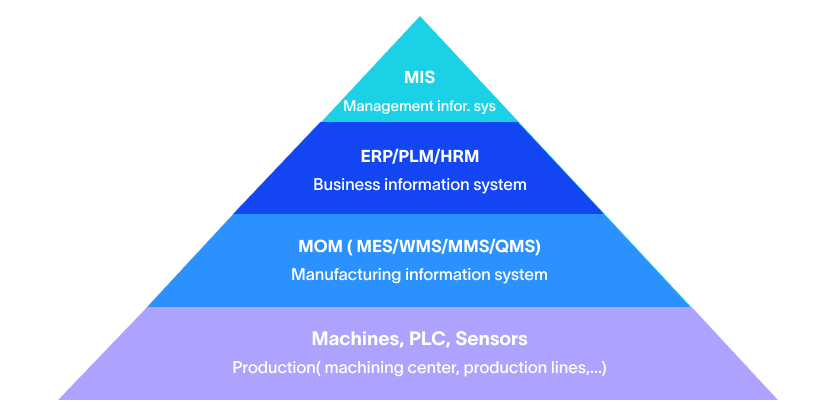The Data Advantage: Why Manufacturing's AI Success Depends on Quality Data Strategy
Blog
7 Min 44 Sec Read
The modern manufacturing sector is uberly competitive. AI in Manufacturing comes with the promise of evolving operations and reducing costs. The companies with the ability to leverage AI optimally can expect unprecedented gains.
However, most companies tend to forget something crucial. The success of AI algorithms depends on the quality of data sets that power the AI consoles. The blatant use of sophisticated AI algorithms does not guarantee any success.
Similarly, West Monroe conducted a ground study. It reveals- “the actual competitive benefit doesn’t lie in the model only. It rather lies in the data that drives it.”
This strategic detail is imperative for manufacturing companies that thrive on data mines, but are unable to embrace the right AI models to capitalize on the staggering volume of data.
The Manufacturing Data Ecosystem
Manufacturing data involves tracking down and recording legions of data sets from numerous sources:
Machine and Equipment Sources:
The primary data sources are real-time data gathered from sensors. The empirical performance metrics also collect a vast amount of data. Then, there are maintenance logs to collect ample data daily. Similarly, the failure patterns also store data.
Lastly, algorithms can be trained on volumes of data from various environmental conditions and quality measurements.
Human Input and System Data:
Systems like MES and ERP can store a rigorous amount of information. Most of these are workflow-related data and scheduling details. ERP also records inventory data.
To increase the volume of data, operators’ manual observations, important production decisions, and insights shared by production managers play a critical role.
AI apps leverage these voluminous data sets to predict operations. The 360-degree data supported AI algorithms can transform the operations of the manufacturing sector.
Time-Series Data: The Manufacturing Intelligence Foundation
To track the dynamic nature of production operations in manufacturing companies, time series data is paramount. Such minute data tracking is convergent towards revealing patterns that traditional reporting never exposes.
The digital data tracking software captures all sensor information over time. They also generate clinical narratives of how production equipment behaves over time.
The AI models that work on these datasets can track the usual operational variance and detect problems at an early stage. The predictive AI apps can also seek help from the time series data available from the Q/A systems.
Combined with the process parameters, predictive AI tools can generate powerful models to analyze quality issues before they arise. Experts say it is an effective way to reduce waste and enhance customer satisfaction.
Want to dive deeper into real-world results? Check out our case study on how a global manufacturer cut unplanned downtime by 30% with AI
Machine Downtime: From Reactive to Predictive
Approximately 5 to 20% of the net productive capacity is dependent on machine downtime. The generic reactive approaches detect failures after they occur. However, the AI-led predictive approaches are a far cry from them.
They track relevant and contextual information to transform the productive capacity. Their readings and interpretations differ significantly from those of simple sensors.
MES Integration: Manufacturing's Central Nervous System
Manufacturing Execution Systems serve as the central nervous system, collecting and orchestrating data flows between shop floor systems and enterprise applications.
INS3’s MES and AI automation implements data-driven systems that solve manufacturing challenges related to quality, efficiency, downtime, scheduling, and ERP connections.
MES Data Advantages for AI:
- Process Context: Connects sensor readings to specific production orders and quality requirements
- Operational Sequencing: Enables AI models to predict downstream impacts of upstream variations
- Resource Optimization: Provides context for AI-driven resource optimization
INS3 engineers seamless data analytics connecting machines → SCADA → MES → ERP, transforming manufacturing data into actionable business intelligence.
Discover the full guide how AI-enhanced MES systems are transforming production efficiency
Overall Equipment Effectiveness: AI-Powered Performance
When powered by comprehensive data collection and AI analytics, OEE becomes a forward-looking optimization tool:
- Predictive Availability: AI models predict equipment failures and schedule maintenance during planned downtime
- Performance Optimization: Real-time analysis recommends optimal operating conditions for maximum throughput
- Quality Prediction: AI in manufacturing models prevents quality issues before they impact production
The Competitive Edge: Data as Strategic Asset
The manufacturing companies that will dominate recognize data as a strategic asset. As West Monroe emphasizes, “fast forward a few years: Having strong AI capabilities won’t be a competitive advantage—it will be table stakes. The companies that emerge in the end will have the most well-structured data sets.“
Building data-driven competitive advantages requires:
- Proprietary Insights: Unique abilities to capture data and run optimizations that competitors cannot replicate
- Faster Innovation: Unique data sets with the ability to process speedier experimentation and prompt validation.
- Customer Value Creation: Advanced datasets can prompt AI models to generate more accurate results, enhance delivery, and reduce costs.
Implementation: INS3's Proven 3-Phase Approach
INS3 has a comprehensive and integrated methodology, developed with the support of several successful implementations to support manufacturers at individual stages of the digital makeover.
Data Foundation Building
- Detailed analysis of the data architecture and a thorough gap analysis.
- SCADA system upgrades are making systems AI-ready
- MES implementation and syncing it with the current production system
- An advanced and secure data collection approach that puts modern cybersecurity suites at the prime
Contextual Data Enhancement
- Operators and production managers can manually capture detailed insights and contribute to informed production decisions.
- Empirical use of time series data to improve the conversion services
- The enhanced visualization dashboards can help in monitoring real-time processes more clinically.
- The QMS can integrate unique connecting processes to help render better outcomes.
AI Implementation and Results
- Predictive AI can go to great lengths to detect equipment failures in real-time.
- Predictive AI can clinically monitor quality and contain defects before they impact production.
- AI-oriented processes can lead to autonomous improvements in the Smart factory.
- Smart process control systems effectively upgrade production units.
Overcoming Implementation Challenges
INS3 has more than 30 years of experience with several SCADA, MES, and miscellaneous empirical projects to offer practical solutions:
Data Quality Issues: Comprehensive data management to clean, label, and prepare AI-ready data through quality enhancement engineering.
Integration Complexity: Seamless data architectures connecting disparate systems, whether legacy or modern UNS architectures.
Cybersecurity Concerns: A cybersecurity-first approach ensures secure data flows while maintaining operational availability.
Organizational Resistance: Collaborative partnership approach focused on understanding unique operational challenges and delivering specific solutions.
Unified Namespace (UNS) Architecture
For modern data architectures, Unified Namespace represents the gold standard for industrial data integration, creating a single, centralized data model providing real-time access to all manufacturing information.
Recommended Architecture Diagram: The “ISA-95 Unified Namespace Architecture” illustrates a hierarchical data flow from Level 0 (sensors/devices) through Level 4 (enterprise systems), with UNS serving as the central data broker that connects the device layer, SCADA/HMI systems, MES applications, and ERP/business systems.
Want to streamline your factory data flow? Learn how Unified Namespace makes it possible.
The INS3 Advantage
INS3 transforms manufacturing data into a competitive advantage through:
- Complete Systems Integration: SCADA modernization to MES implementation to AI Strategy in manufacturing solutions
- Proven Manufacturing Intelligence Expertise: 30+ years with hundreds of successful SCADA, MES, and data historian implementations
- Proven Process Methodology: Systematic approach developed through extensive project experience ensures consistent results and minimizes risk
- Technology-Agnostic Approach: Certified with industry’s best platforms while introducing new technologies when needed
- End-to-End Support: Concept through implementation to ongoing optimization
Measurable Business Impact:
- Reduced downtime through predictive maintenance
- Improved efficiency through optimized production scheduling
- Quality enhancement through statistical process control
- Cost reduction through comprehensive data analytics
- Faster decision-making through real-time operational visibility
Taking the Next Step
Whether you are beginning digital transformation or optimizing existing systems for AI, INS3’s engineering services unlock the full potential of your manufacturing data. Our approach starts with understanding the unique operational challenges and develops solutions that demonstrate clear business value and measurable ROI.
Our Commitment:
- Every solution demonstrates clear business value and measurable ROI
- Technology implementations enhance rather than disrupt operations
- Long-term partnerships focused on continuous improvement
- Expertise spanning operational technology and business strategy
The race to adopt AI in manufacturing is ultimately a race to develop superior data strategies. Companies partnering with experienced providers like INS3 achieve sustainable competitive advantages that are difficult for competitors to replicate.
As West Monroe concludes, “the difference-maker? Context-rich, trustworthy data that reflects your business and industry.” This means comprehensive data strategies that capture the full complexity of production operations, enabling AI to deliver transformational business value.
The manufacturing companies that will dominate the next decade recognize data as their most valuable asset and develop comprehensive strategies to capture, govern, and apply that data through AI-powered insights. The time to build these capabilities is now.

Agile MES: The Key to Unlocking Smart Manufacturing Success
MES is a computerized system used in manufacturing operations to track and document the transformation of raw materials into finished goods. An MES system typically manages and monitors work orders, equipment, materials, and personnel on the shop floor. The system provides real-time visibility into production processes, helps optimize manufacturing operations, and improves the overall efficiency of the manufacturing process.

Understanding OEE: The Key to Manufacturing Efficiency
In today’s competitive manufacturing landscape, improving efficiency and productivity is crucial for businesses to remain competitive. One of the key metrics used to measure manufacturing efficiency is OEE or Overall Equipment Effectiveness. In this blog, we will take a closer look at OEE and its importance in manufacturing.

How to Effectively Conduct a Legacy System Integration
Legacy system integration can be a daunting task, but it’s a necessary one for many manufacturers that rely on outdated systems to run their business. Integrating legacy systems with modern technology can improve efficiency, streamline processes, and save time and money. However, it’s important to approach the integration process carefully and methodically to ensure success.
Share on :
Keep On Reading
Subscribe to Our Newsletter
Subscribe to our weekly newsletters to get updates regarding our new production, behind the scene process of our art creation and much more.
After submitting this form you will receive an e-mail with a confirmation link that you must click to complete your request. Detailed information on processing and cancellation can be found in our privacy policy.

